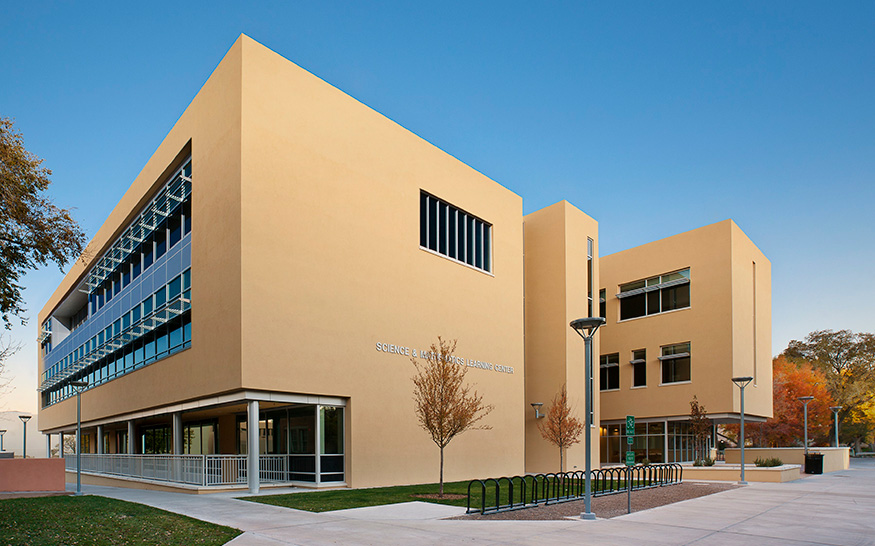Chemistry Dept. Equipment

NMR Laboratory Facility
The NMR Facility at UNM is housed in the Department of Chemistry and Chemical Biology. It contains three NMR spectrometers. The Bruker Avance HD 500 is primarily a solution NMR, with VT, a third RF channel, gradients, and 3 solution probes. They are: 5 mm broadband with VT, gradients, and liquid nitrogen cooled electronics; 5 mm inverse triple (proton, phosphorus, broadband) with VT and gradients; and 2.5 mm inverse broadband with VT and gradients. It can perform 1, 2, and 3D NMR experiments.
The Bruker Avance III Solution 300 is a liquids-only two channel system. It has has both 5 mm and 10 mm H/BB probes, VT, and gradients. It is fully multi-nuclear and can perform 1, 2, and 3D NMR experiments. We are grateful to the National Science Foundation for awarding us a grant to purchase this system.
The Bruker Avance III Widebore 300 is a solids-primarily instrument. It has VT, a third channel, and 8 probes. The probes are: 7 mm CPMAS, 4 mm CPMAS, 2.5 mm HFX CPMASS, 7 mm CRAMPS, 7 mm triple resonance, a wideline probe with both 5 and 10 mm inserts, and a DOR probe. There is also a 5mm solution H/BB probe with VT and gradients. This system can perform most solid or liquid 1, 2, or 3D experiments. We are grateful to the National Science Foundation and ARRA for funds to upgrade this system.
Mass Spectrometry Facility
The Mass Spectrometry Facility of UNM is a resource where the facility director performs small molecule analyses using Waters LCT Premier orthogonal acceleration time-of-flight (OA-TOF) mass spectrometer. The mass spectrometer has high resolution molecular MS capability. The instrument provides good sensitivity across the full mass range affording low detection limits for analytes with enhanced mass resolution and is equipped with a modular lockspray interface for high accuracy exact mass and elemental composition calculations of molecules. LCT Premier utilizes versatile ionization platforms (ESI, APCI, APPI, etc.) that apply to a wide array of compound classes and provides in-source collision induced dissociation (CID) for structural identification of unknown compounds. These features coupled with high accuracy exact mass analyses provide platform for characterization of small molecules to screening large compound libraries.
Small Molecule X-ray Crystallography Facility
The UNM Chemistry Department shares an X-Ray Laboratory with Sandia National Laboratories at UNM’s Advanced Materials Laboratory. The facility possesses a Bruker X8 APEX Single-Crystal X-Ray Diffractometer with high sensitivity CCD detector, which serves the structure determination needs for the department, the University and other institutions.
Photoluminescence Facility
The Kirk group shares an Edinburgh Instruments FLS980 research grade modular fluorimeter in the 1000 sq. ft. laboratory that houses our two UV-Vis-NIR spectrometers and associated cryostats. The FLS980 is used to acquire steady-state excitation and emission photoluminescence spectra in the UV-VIS-NIR spectral range for the study of novel electronic and solar energy related materials. Time-resolved photoluminescence capabilities have recently been purchased for this facility.
UNM Center for Advanced Research Computing
The UNM Center for Advanced Research Computing (CARC) supports high performance and data intensive computing by the entire UNM community. Resources available to support this project include the 280-node/2240-core Wheeler capacity compute cluster, the 32-node Xena NVIDIA GPU cluster, and the 1.5PB Research Storage Consortium storage system.
These systems are housed in CARC's dedicated research data center with 2 UPS systems and 3 Liebert AC systems; together they provide 270 kVa of UPS capacity and 70 tons of dedicated cooling, maintaining a time window for riding out transient power loss or cleanly shutting down systems in the event of longer outages.
CARC systems are connected to campus by multiple 10G connections, including a dedicated 10G connection to UNM's Science DMZ research network. Wide-area Internet connectivity to UNM includes 100G connections to the DOE Energy Sciences Network (ESNet) and the Western Regional Network, both through the Albuquerque Gigapop.
